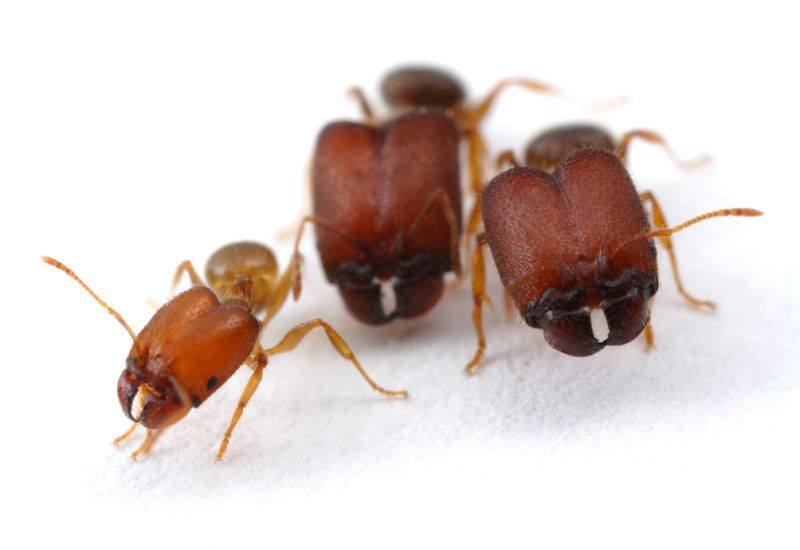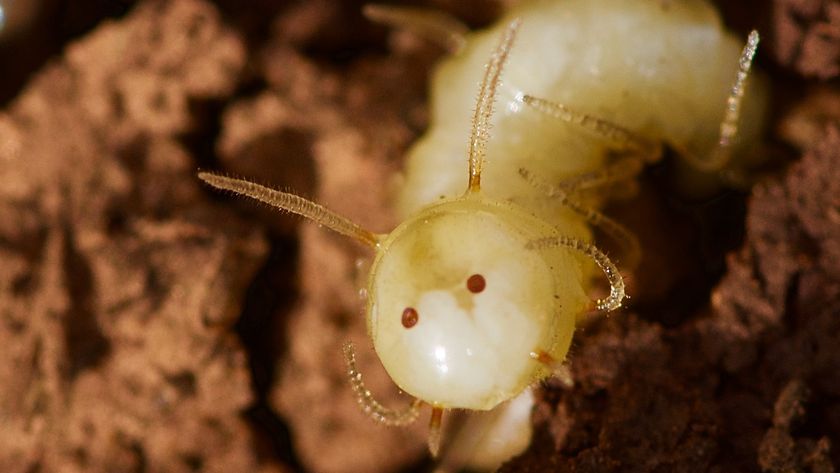Scientists Make Supersoldier Ants

When eight bizarrely big-headed soldier ants turned up in a wild colony collected from Long Island, N.Y., scientists knew they had found something interesting.
This discovery of these oversized versions of soldier ants, whose job is to defend the nest, led researchers to create their own supersoldier ants in the lab with the help of a hormone, and, by doing so, offer an explanation for how ants, and possibly other social insects, take on specific forms with dedicated jobs within their colonies.
It turns out these abnormal soldier ants were throwbacks to an ancestral state, one that no longer shows up within their species except, apparently, by accident. This phenomenon occasionally pops up elsewhere, in the form of whales bearing limbs their ancestors lost, chickens with teeth or humans with tails. [10 Vestigial Limbs & Organs]
"It's been known for a long time that these kinds of slips occur, and they are viewed as the Barnum and Bailey of evolution," said the study's senior researcher Ehab Abouheif, Canada research chair in evolutionary developmental biology at McGill University. "What we are showing for the first time is there is this ancestral potential sitting there, and when poked by the environment it can really unleash this potential that can power evolution."
Meet the supersoldiers
The species collected in New York, Pheidole morrisi, normally has two types of worker ants, according to Abouheif: minor workers, which are responsible for foraging, nursing, feeding eggs and larvae, and taking care of the queen; and soldier ants, which defend the nest and use their big mandibles to crack seeds harvested by the minor workers.
This species doesn't have supersoldiers, but the big-headed critters resembled the supersoldier ants occurring among eight species of ants found in the American Southwest and northern Mexico. All nine species belong to the genus Pheidole, which contains about 1,100 species.
Sign up for the Live Science daily newsletter now
Get the world’s most fascinating discoveries delivered straight to your inbox.
So it made sense that the out-of-place supersoldiers could reveal something about the origin of supersoldiers among the eight other species.
Making a supersoldier
To find out, the researchers, led by Rajendhran Rajakumar, a doctoral student in Abouheif's lab, watched the development of supersoldier larvae from two of the eight species that normally produce them. (The researchers wanted to study the behavior of the P. morrisi they had collected, but they were killed in the lab by other ants.)
An ant's caste, or role in the colony, is determined by environmental switches, or periods during its larval development when it is receptive to certain environmental cues. Adult ants in the colony can manipulate these switches by, for instance, applying certain hormones called pheromones to the larvae.
In the first period of development, this switch determines whether the egg will become a queen or a worker and then another switch second determines whether the larva will become a soldier or a minor worker.
Just before the second switch, they applied a chemical that acts like juvenile hormone to the larvae of three species that do not produce supersoldiers. Juvenile hormone is involved in translating environmental cues, such as nutrition, into the identity of the larvae. By applying it artificially, the researchers not only pushed the larvae past the threshold at which they would normally become regular soldiers, but past a second threshold, one that is normally hidden, creating supersoldiers.
But these lab-created supersoldiers weren't perfect matches to the natural ones. As adults they retained little vestigial wings buds, something normal supersoldiers lose when they mature.
"The potential [to be supersoldiers] is there, but it is a little raw," Abouheif said.
The researchers also looked at the expression of a gene involved in the control of wing development, and found similarity between the lab-induced supersoldiers and the natural ones. They also found similar changes occurred in two different species of naturally occurring supersoldiers, this indicated both relied on the same developmental mechanism.
So why have supersoldiers?
The naturally occurring supersoldiers appear to have a defense function. These species live in the same areas as army ants, which attack their colonies. During a raid, the supersoldiers use their large heads to block the tunnels to their nests to keep the attackers out.
However, other species of Pheidole ants, those without supersoldiers, also live alongside army ants. One of the species in which the researchers induced the supersoldiers, P. hyatti, grabs its brood and climbs up stalks of grass to escape army ant raids.
Moreau suggests another reason the giant heads of the supersoldiers might come in handy: grinding seeds. Supersoldiers could grind larger seeds than regular soldiers, she said.
A mystery from the family tree
The findings could help to solve a mystery of the origin of such supersoldier ants. Past work by Corrie Moreau, an evolutionary biologist at the Field Museum in Chicago, who was not involved with this study, revealed that one of the supersoldier species is located near the base of the Pheidole family tree, closely related to the ancestral ant, while other supersoldier species were scattered within the tree.
There are two possible explanations for this arrangement: Either each of the species evolved different ways of creating supersoldiers, or the mechanism evolved with the earliest common ancestor about 35 million to 60 million years ago, according to Moreau.
The work of Abouheif's team points to the latter — that supersoldiers date back to the root of the family tree — and it reveals how supersoldiers are created.
The implications extend beyond ants, according to Moreau.
"The question becomes, 'Do all insects use a similar pathway as was found in the big-headed ants or is this something special to this group,'" she wrote in an email to LiveScience. "Regardless, it suggests that we should look for evolutionary conserved pathways across the tree of life."
You can follow LiveScience senior writer Wynne Parry on Twitter @Wynne_Parry. Follow LiveScience for the latest in science news and discoveries on Twitter @livescience and on Facebook.
Editor's Note: This story was updated on Jan. 6 at 10:25 a.m. to reflect the correct spelling of the Ehab Abouheif's name.












